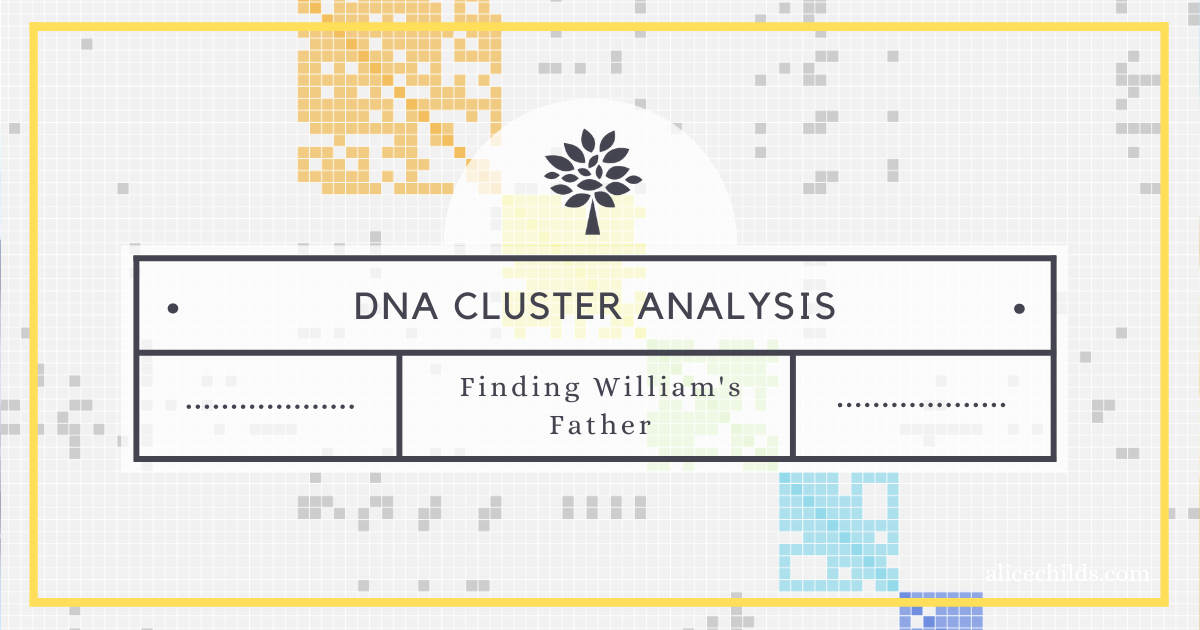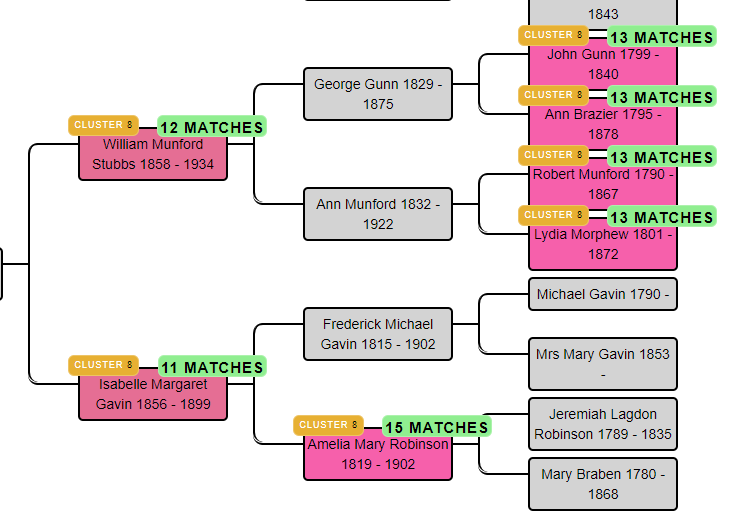
Last weekend while working on my DNA project, Finding William’s Father, I uploaded DNA data to MyHeritage and Gedmatch. While waiting for the DNA to finish processing, I created a timeline of Ann Munford’s life and analyzed my sources. This past weekend, I spent some time clustering matches and analyzing the clusters. I used both manual and automated methods because I wanted to practice using a few different clustering tools.
The first thing I did once the DNA was processed at MyHeritage was to request an AutoCluster with the threshold for shared cM set at 45-350 cM. Once the report was emailed to me, I spent some time looking at the trees of matches in each cluster to try to determine the common ancestors. I was able to identify common ancestors in each cluster, and none of the clusters appear to belong to the Stubbs/Munford line, so I decided to move on to clustering tools for AncestryDNA matches.
I first used the Leeds method. According to Dana Leeds, creator of the Leeds Method, “this method uses a spreadsheet to sort DNA matches into color groups based on shared ancestors. It often creates four groups of DNA matches based on four grandparent lines.” I added all the second and third cousin matches (those sharing 90-400cM of DNA) to a spreadsheet, then assigned each of them a color based on shared matching as described in this post by Dana Leeds on her website. It was really interesting that I did get four distinct grandparent groups using this method. It doesn’t always happen that way, for various reasons that Dana discusses in her post. By looking at the trees of the DNA matches, I was able to identify which grandparent each color group belonged to. Here’s a snapshot of the first few matches on the list:

Cluster 2 (yellow) includes William Munford Stubbs’ line, and I spent some time trying to identify matches with ancestors that I don’t recognize, thinking that they might descend from William’s unknown father. I did identify a few and made note of them for future analysis, but I decided that I would also like to try some additional automated tools to help with this step. I attended a couple of sessions at RootsTech that talked about the tools at Genetic Affairs, and I remembered they had a tool called Auto Tree that identifies common ancestors and reconstructs genealogical trees based on the trees of DNA matches.
With Genetic Affairs, you can create an auto cluster with AncestryDNA results, so I did that, selecting the Auto Tree option as part of the cluster analysis and 35 cM as the lower threshold. Depending on what I am able to discover, I may need to decrease the lower threshold to provide additional matches to help answer my research question.
Within just a few minutes, I had my Auto Cluster report. With this report, I was able to easily identify a Stubbs group. Many of the matches in this group are descendants of William Munford Stubbs and his wife Isabelle Margaret Gavin, but there are a few that appear to go back to a common ancestor a generation or two back. I am excited to dive in and research the trees of these matches.
Genetic Affairs has some really cool features. First, when looking at the cluster report, the column at the right provides names that appear in the matches’ trees in each cluster. This made it easy to identify Cluster 8 as belonging to the Stubbs line.

Another option is to view common locations. In the picture above, you can see that there are 66 common locations within 100 miles of each other for Cluster 8. When I clicked on the link to view common locations, each location was shown, along with persons that had events in those locations. Below is a list of matches that have William Munford Stubbs’ birthplace of Hethel in their trees. It would be really exciting if there were people other than William Munford Stubbs in the person list at the right because that might point to a possible father for William, but I have 66 common locations to explore in this report. Locality research combined with traditional genealogy will help me determine which places are closest to where Ann Munford was living when William would have been conceived.

Here is a small snapshot of the Auto Tree feature at Genetic Affairs. It basically charts the path from the DNA matches to their common ancestors. I love this feature! I had a long list of Auto Trees for the DNA matches in Cluster 8. Many of them point directly to William Munford and his wife as ancestors. Some point to Ann Munford’s parents, and a couple point to ancestors I am not familiar with. I will need to explore their trees to learn more.

I do see one immediate cause for caution when using these tools. Here is a snapshot of part of the Genetic Affairs report called “Common Ancestors Overlaying on 5 Generations of Your Ancestry.”

The problem? This chart shows George Gunn as the father of William Munford Stubbs, with 13 DNA matches to support the connection. I happen to know that George is William’s stepfather, not his biological father. Ann Munford married George Gunn when William was five years old. If I didn’t already know that fact, it might be tempting to think that I had found William’s father when viewing this tree. These DNA matches share DNA with William’s descendants through his half-sibling relationship to Anne Munford and George Gunn’s children. It is very important to do traditional genealogical research along with careful DNA analysis when trying to discover unknown ancestors using DNA.
I need to continue learning all the features of my Genetic Affairs Auto Cluster + Auto Trees report and gain a better understanding of what the report is telling me. I’m excited to keep analyzing this report and hopefully pinpoint DNA matches that will help lead to William’s father.

Great info and great caution about verifying with traditional records. Love these posts!
Great post Alice. With respect to the step father of William. How do you explain that there are 13 matches linked to the father (John Gunn) of the step-father. Since there is no biological link, how is the link established?
I am sorry I had to stop the Ancestry service…. hopefully can get it back in some other form.
Evert-Jan,
Thank you so much for taking the time to read my post and comment. I appreciate it so much. This is a complicated family. Ann Munford (William’s mother) married George Gunn (William’s stepfather). Ann’s brother Thomas Munford married George Gunn’s niece Elizabeth Gunn, so there is a biological connection to both the Gunn and Munford families through Thomas. I think that explains why some matches would be linked to George Gunn’s father John Gunn. If I am mistaken, I would love to hear feedback! In addition, some DNA matches have erroneously added George Gunn as the father of William Stubbs. Would that factor into the equation?
I’m glad I was able to use Genetic Affairs with my Ancestry matches prior to Ancestry service having to stop. Thanks for all you do. There are some really amazing tools at Genetic Affairs!
Thanks for the feedback! I sure hope I can provide the same tools in the near future but I’m
afraid it won’t be as user friendly as it once was (nor as quick).
So Ann Munford her brother Thomas is linked to Elizabeth Gunn. Let me think,
descendants of that couple Thomas and Elizabeth have as common ancestors John Gunn
and Ann Brazier as compared with William Munford. They are DNA matches with your tested
person because they received that DNA from the Munford line. However, since these descendants of Thomas and Elizabeth have the Gunn line, it seems like the Gunn line is indeed part of the Williams line as well. I wonder if the lack of linked DNA matches to George Gunn and Ann Munford might be indicative of this non-biological relationship.
Interesting! It will be interesting to see the ancestors if you do manage to find his biological
father and integrate that in the tree. I think there is something to learn from this example and
like you indicate, important to keep all options open and not to jump to conclusions.
Nice work!